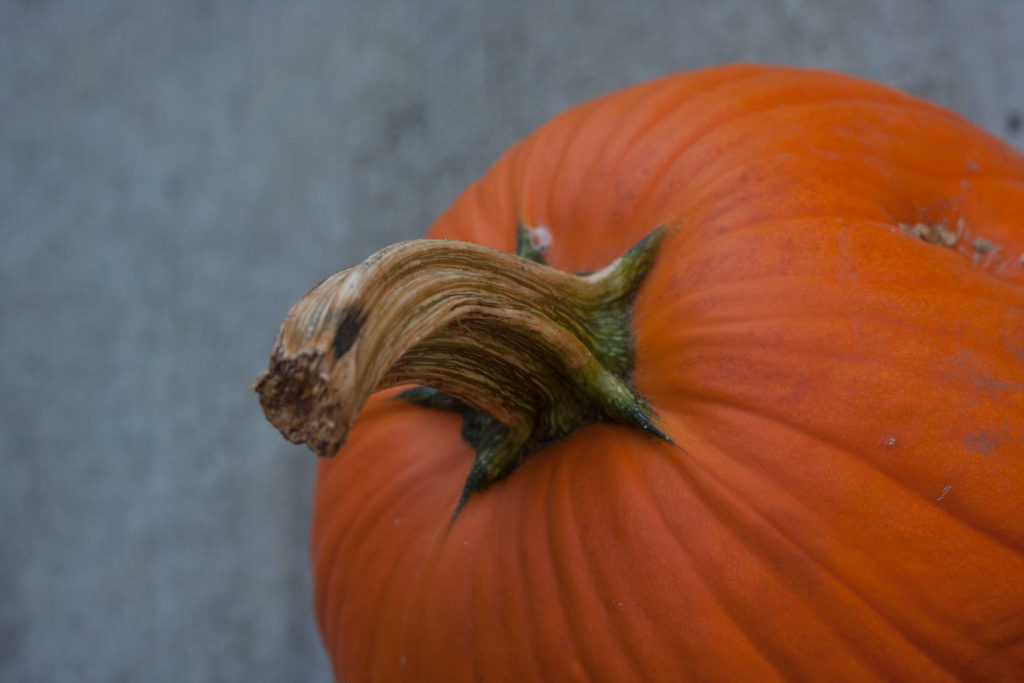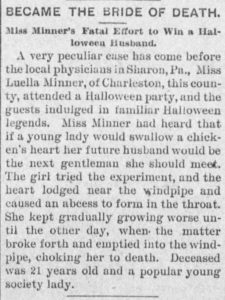Have a drink with: Single Ladies (Halloween Edition)
Burning hair, apples, chicken guts, lead poisoning.
Ask her about: Do you know the Heimlich maneuver?
For most of American history, Halloween was not a holiday for children. Quite the opposite: to the extent Halloween was celebrated at all, by the 19th century it was known as an occasion for creepy seances or playful mischief-making by the adolescent set, where “playful” is mostly a euphemism for “requiring the assistance of the fire department.” (So intense was the prankster habit that one local fire chief sighed that, while he had no problem with teens celebrating the holiday with some reasonable pranking, “when droves of youngsters march through the streets pelting citizens and houses with vegetables he will make somebody answer for it.”)
People at the turn of the century would have had no concept of Halloween as the sort of holiday with small children playing charming dress-up, adults playing unnecessarily sexualized dress-up (seriously: WHY?), and everybody just doing it all for the Snickers bars.
They were too busy looking for their future spouse in the basement mirror.
Folks during the 19th century definitely kept Halloween on their calendar, and for one reason in particular: many people believed it was a one-day license to get access to predictions about the future. It stood to reason: October 31st was a ghostly day, when all the spirits and dark forces came to earth to whoop it up before the sobriety of All Saints Day. All that supernatural activity allegedly lifted the veil that normally kept the secrets of the spirit world obscured from daily view. So why wouldn’t you indulge in a little superstition if it helped you figure out something about your future, to wit: who was Mr. Right, and where was he?
A whole suite of superstitious rituals became common for young ladies hoping to wake up November 1st with a plan for their dating future:
I’ll Keep The First Aid Kit Handy?
While repeating a particular verse of rhyme, women “must walk backwards down the cellar stairs of the house, if she has one, and of the flat building in which she lives, if it so happens. Her hair must be loosened and hang at length down her back. She must wear no shoes, because squeaky shoes and mysteries never should go together. Arriving at the foot of the stairs the young woman with a future instead of a past must turn carefully about twice, take ten steps, look carefully over her right shoulder, and then, holding the candle which she must of course carry in her hand, look directly in a glass, which, during some hour of the previous day, should have been hung on the cellar wall at a designated point. If fate has a marriage in store for her, when she looks into this glass she will see, instead of the reflection of her own face, that of the man who is to be all in all to her.”
There’s Gilded Age expectations of women for you. Men: see if you can hang a sleigh out a second-floor window: bonus points for setting it on fire! Women: please walk down to the basement backwards in a long dress while carrying a lit candle and reciting poetry. Know what? Just stay down there, matter of fact. We’ve got cabbages to hurl.
Love Stinks.
“Another opportunity which the young woman may seize to learn how long it will be before she is to be married is found in the burning of a hair.”
Wait, what?
“Take a hair from the back of the head. Light a match and let the hair take fire. If it burns an inch and then the fire dies out, marriage will come within a year. After that a year should be counted for every half-inch which the flame destroys. This is said to be absolutely positive, and if the experiment ever proved unsuccessful there is no record of it.”
Naturally. IT’S SCIENCE. Like breastaurants.
We’re Gonna Need A Bigger Spoon.
Lead divination was another popular Halloween pastime. For this game: “A boy with a steady hand melts some big chunks of lead in an enormous iron spoon.”
What could go wrong?
“Then each girl takes a turn at pouring a few drops of the bright liquid metal into the tub of water, and by the shape which the lead takes the occupation of her future lord and master is made known.”
There is no Dana; only Zool.
“It is surprising what very definite forms the metal will assume to young eyes.”
Is it now? In the end, though, let’s be honest:
It’s All Fun and Games Till Someone Swallows a Chicken.
Presented without comment.
Fun Facts:
Bobbing for apples has a long history as a Halloween tradition: in the 19th century it was often called “ducking for apples,” and if a person was able to pick up an apple in her teeth three times within five minutes, they would perhaps dream of their future spouse when they went to bed that night. Many traditions involved apples – a nod to the fall harvest – and requested that, in the course of one or more of these games, that a young woman peeled or ate an apple, or went bobbing, or roasted one hung over a fire on a string to see which would drop first. In one version, if you peel an apple in one go and toss the peel over your shoulder, it will fall in the shape of a telltale initial.
Lead divination is also known as molybdomancy, and apparently it’s a new year’s tradition in Finland.
There are scads of Halloween games and traditions, many (though not all) focused on relationships. Roast two chestnuts together: do they roast side-by-side or leap apart in a pop of the flames? Bake a “dumb cake” whereby a creepily silent coven of young women bake a cake and wait for an eligible man to walk into the kitchen with his eyes on one of them. Nail a green peapod to the door lintel. Try to get needles to float on a glass of water. Count the seeds in yes, an apple:
Additional Reading:
All quotes and images from the following, available via newspapers.com:
“Halloween: Take A Peep at the Future Tonight,” The Los Angeles Herald, October 31, 1897
“Plays for Halloween,” Philadelphia Inquirer, October 29, 1893
“The Festival of Hallowe’en,” Minneapolis Star Tribune, October 29, 1899
“Became the Bride of Death,” Topeka Daily Press, November 16, 1895
“Halloween Superstitions,” Democrat & Chronicle, October 13, 1899


